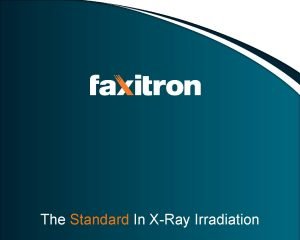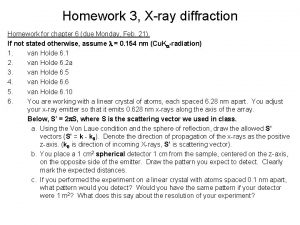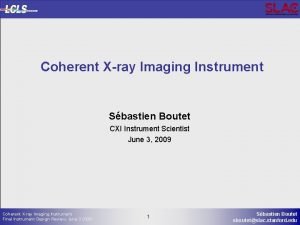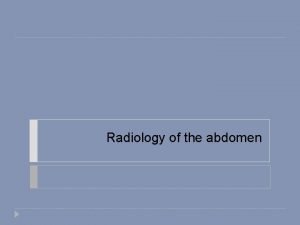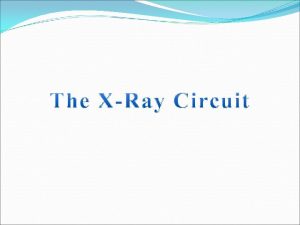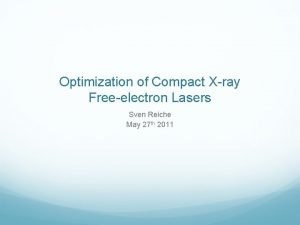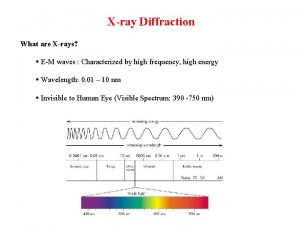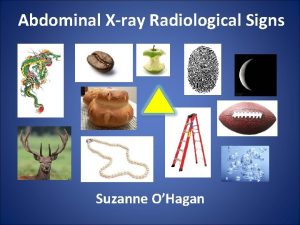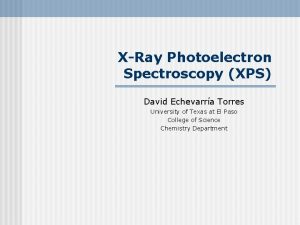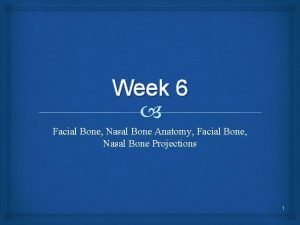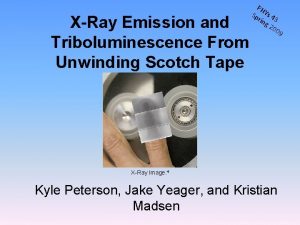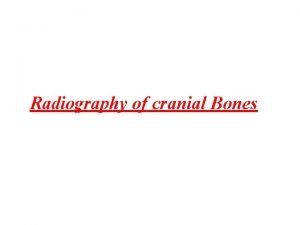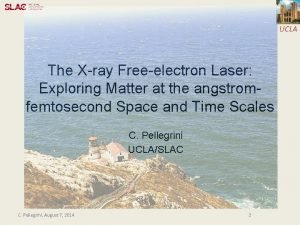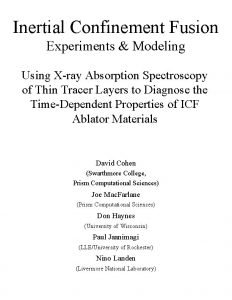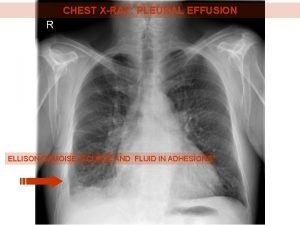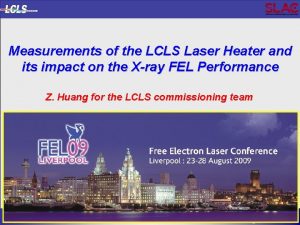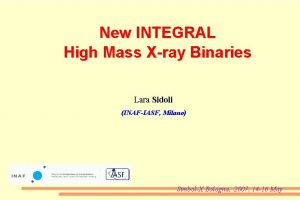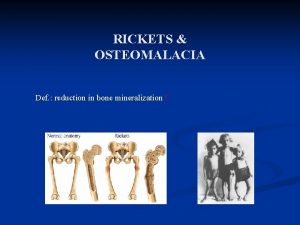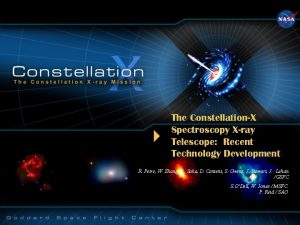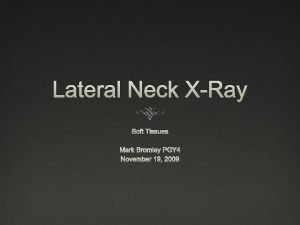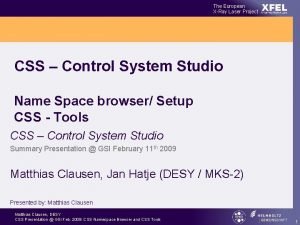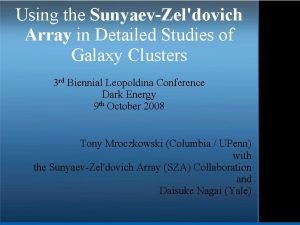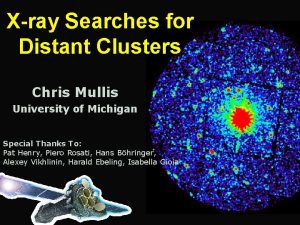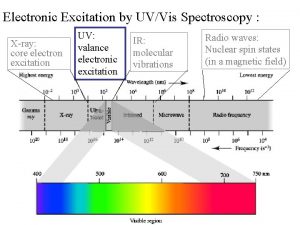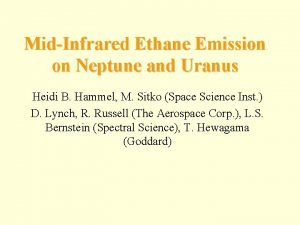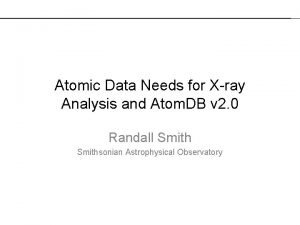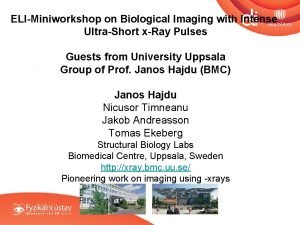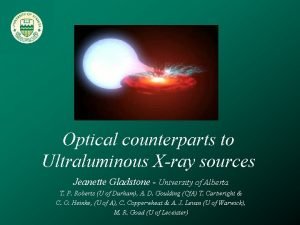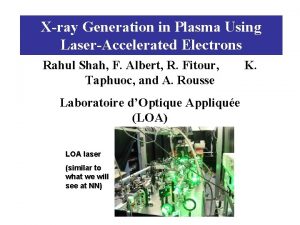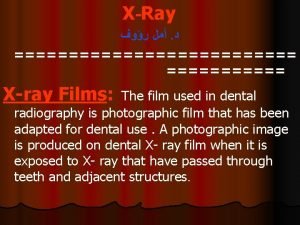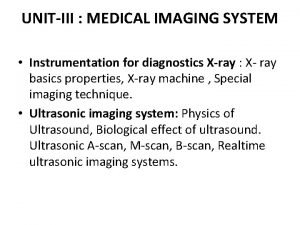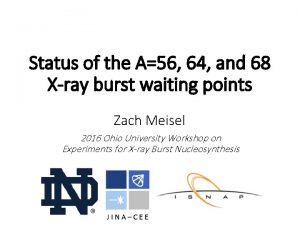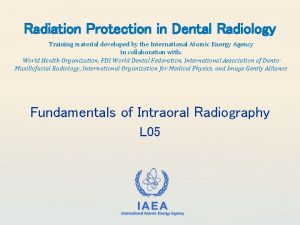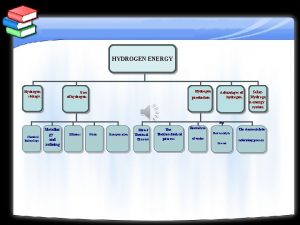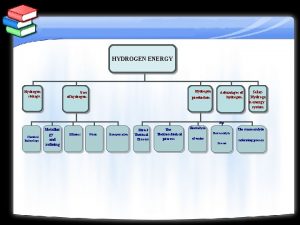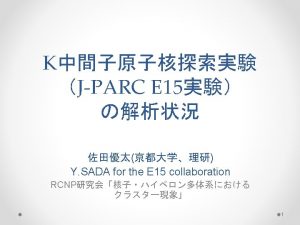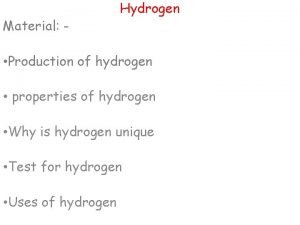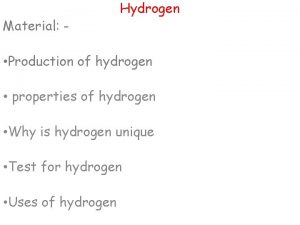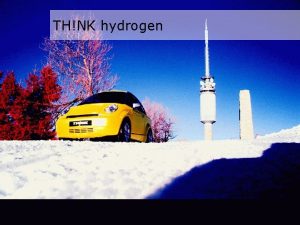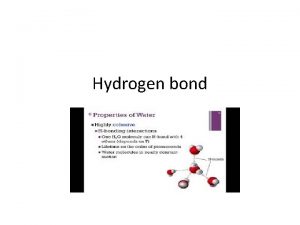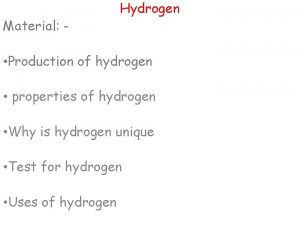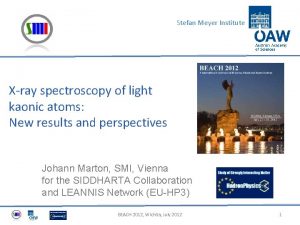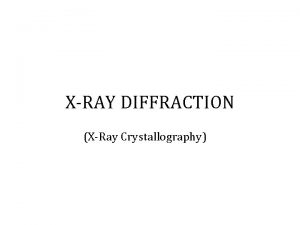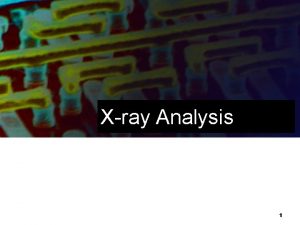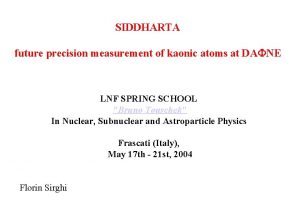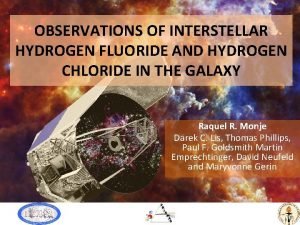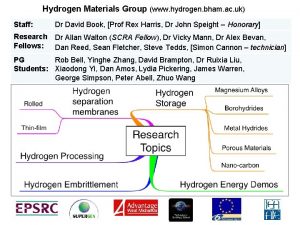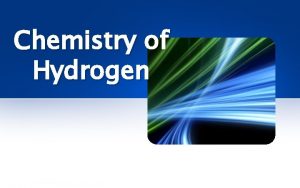Results from the kaonic hydrogen Xray measurement at



























































- Slides: 59

Results from the kaonic hydrogen X-ray measurement at DAFNE and outlook to future experiments Michael Cargnelli, Stefan Meyer Institute, Austrian Academy of Sciences, Vienna On behalf of: The SIDDHARTA collaboration

SIDDHARTA 1) how ? SDDs Goal: measure the shift and broadening of X ray transition energies in light kaonic atoms. The ground state is affected by the strong interaction between the kaon and the nucleus. e, G are input for effective theories in low energy QCD Triple coincidence: SDDX * Scint. K 1 s level shifted and broadened X K- e+ E (2 -1) el. mag. = 6. 480 ke. V SDDs What, why. . ? Scint F Scint e- K+ New X-ray detectors (SDD silicon drift detectors) § timing capability background suppression § excellent energy resolution § high efficiency, large solid angle § performance in accelerator environment 1) Silicon Drift Detectors for Hadronic Atom Research with Timing Application STORI‘ 11 - M. Cargnelli - 2

Hadronic atoms _ Objects of type (K X), (p-, X) with X = p, d, 3 He, 4 He, . . or p+ p- p. K _ p He Bound electromagnetically, binding well known Strong interaction (mediated by QCD) modify binding decay of object in some cases: small perturbation energy shift and width can be related to T-matrix elements at threshold (Deser 1 type formulas) compare to results from low energy scattering experiments 2 Low energy phenomena in strong interaction can not be described in terms of quarks and gluons, instead effective theories are used (they have some degrees of freedom) 1 original 2 Deser relation in some cases not sufficient to compare to high precision experimental data problems: extrapolation to E=0 and quality of old experimental data STORI‘ 11 - M. Cargnelli - 3

Theory and experiment Chiral perturbation theory was extremely successful in describing systems like p. H, but can not be used for KH. Main reason is the presence of the (1405) resonance only 25 Me. V below threshold. There exist non-perturbative coupled channel techniques which are able to generate the (1405) dynamically as a Kbar N quasibound state and as a resonance in the p S channel Effective field theories scattering data atomic X ray data energy, width of resonances . . needs input from experimental data. . aims at accomodating all experimental evidence High precision low-energy-QCD results can be compared with experimental data STORI‘ 11 - M. Cargnelli - 4

Scattering lengths – Deser formula _ With a 0, a 1 standing for the I=0, 1 S-wave KN complex scattering lengths in the isospin limit (m d = mu), m being the reduced mass of the K-p system, and neglecting isospin-breaking corrections, the relation reads: … a linear combination of the isospin scattering lengths a 0 and a 1 to disentangle them, also the kaonic deuterium scattering length is needed (contains a different combination of a 0 a 1 STORI‘ 11 - M. Cargnelli - 5

Summary of physics framework and motivation Exotic (kaonic) atoms – probes for strong interaction hadronic shift ε 1 s and width Γ 1 s directly observable experimental study of low energy QCD. Testing chiral symmetry breaking in strangeness systems Kaonic hydrogen Kp simplest exotic atom with strangeness more precise experimental data important atomic physics: new cascade calculations Information on (1405) sub-threshold resonance responsible for negative real part of scattering amplitude at threshold important for the search for the controversial „deeply bound kaonic states” Determination of the isospin dependent KN scattering lengths no extrapolation to zero energy kaonic deuterium needed, never measured before STORI‘ 11 - M. Cargnelli - 6

D AF N E electron-positron collider, energy at phi resonance phi produced nearly at rest. (boost: 55 mrad crossing angle → 28 Me. V/c) charged kaons from phi decay: Ek = 16 Me. V degrade to < 4 Me. V to stop in gas target SIDDHARTA was set up here compare situation during DEAR data taking (2002) currents ~ 1200/800 ~ 1 pb-1 per day, peak ~ 3× 1031 cm-2 s-1 Φ production cross section ~ 3000 nb (loss-corrected) Integr. luminosity 2009 ~ 6 pb-1 per day 1) (~ 107 K± ) (increased by crabbed waist scheme) Peak luminosity ~ 3 × 1032 cm-2 s-1 = 450 Hz K± 1) we can not use kaons produced during injections. STORI‘ 11 - M. Cargnelli - 7

The experimental challenge. . . to do low energy X ray spectroscopy at an accelerator The radiation environment produces a lot of charge in Si detectors (d. E > 150 ke. V) „Beam background“ Touschek- Babha- and beam-gas-scattering, stray high-energy e± => e. m. showers. not correlated to charged kaon pairs: (1) „accidentals“ m, p, e from K decay; L, p, . . from K- absorption, kaonic X rays from K- wallstops synchronous background – has trigger signal – remains in triggered setup (2) kaonic X-ray lines (3) continous kaon correlated background S: Signal, B: background, T: trigger rate, ST : signal per trigger Dt: coincidence width A: accidental rate BT: background in ROI, per trigger (lines+continous) STORI‘ 11 - M. Cargnelli - 8

e+ SDDs Experimental setup X K- Scintillator F K+ Scintillator 2 scintillators remote controlled mechanism to remove during calibrations STORI‘ 11 - M. Cargnelli - 9 e-

Data analysis Data aquisition: - energies and detector numbers of X ray hits - event id-number, time-tag if a kaontrigger happend: - the time correlation between X-ray and kaon - the kaon detector parameters - DAFNE beam-current values From this we derive in off-line analysis: - the kaondetector TOF to discriminate against MIPS - kaondetector position information from the timedifference of the PMs at both ends - sdd rates (e. g. counts during last second) - kaon rates ( -- „ --) - number of hits without vs. hits with kaon coincidence - multiplicity of hits - kaons per X-ray Analysis tasks: - periodically calibrate the >100 individual detectors (gain alignment), discard ‚bad‘ ones - determine the energy resolution (response shape) of the summed detectors - fit the spectrum with signal-components, background lines and continous background STORI‘ 11 - M. Cargnelli - 10

Calibration every ~ 6 h calibration run with X-ray tube + beam summed spectrum of 1 calibration run ~ 100 detectors Ti: Ka 1, 2 Kb Mn: Ka 1, 2 Fe: Ka 1, 2 Kb Cu: Ka 1, 2 Kb esc. Ka, esc. Kb Zn: Ka 1, 2 Kb Au: La 1, 2 Ti Ka Ti Kb Mn Ka Cu Kb Fe Ka Fe Kb Zn Ka in 10 min enough counts on each of the 133 detectors ! derive ADC channel of Ti Ka and Cu Ka position calibrate each (channel => ke. V) fit with gaussians automatically select detectors using resolution- and chisquare cuts Au La ke. V excellent statistics, many lines identifyable deviation from pure gaussian shape ! different approximations possible. Here: convolution of with exponential tails: zi = S wi-j yj wk = N exp( – k l-) k < 0 1–e k=0 N exp( – k l+) k > 0 STORI‘ 11 - M. Cargnelli - 11 S wk =1

Calibration cont‘d selftrigger spectrum, continous background subtracted gain slightly changing with detector rate and with presence of large signals Au La => used X-ray tube DURING beam Cu Ka studied rate dependance by varying X ray tube intensity final energy adjustment at exact data-taking conditions possible by looking at a) the selftriggerspectra => Cu, Au fluorescense lines excited by background e < 1 e. V b) the coincidence spectra = kaonic lines from wallstopps KC, . . e ~ 2 e. V Fe Ka Cu Kb Fe Kb Zn Ka energy (ke. V) Remark on the response shape of the SDDs consider edge effects charge transport depends on distance from anode sum of gauss functions is not a gauss function (adding different resolutions) => measured response understood FWHM @ Cu Ka = 174 e. V consistant with X-tube measurement (with low intens. ) most precise response-shape from low rate X-tube measurement position of Cu Ka ~ slightly shifted as compared to the periodic X-tube calibrations STORI‘ 11 - M. Cargnelli - 12

kaon correlated accidentals Coincidence data hydrogen Region of kaonic hydrogen K lines kaon correl. accidentals (normalized) deuterium kaon correl. acc. STORI‘ 11 - M. Cargnelli - 13 K correlated background: decay secondaries from K+, KK- absorption secondaries K- kaonic X-rays, wallstops, gasstops accidental background: electromagnetic showers resulting from lost e+ e-

Fit model for the signal (shift and width: this exp. ) Jensen overlapped distributions ! Intensity ratios not known precisely => fixing would introduce theory dependance (3 -1) Koike 5 fitparameters: I 4 = yield(4→ 1) I 5 = yield(5→ 1) I 6 = yield(6→ 1) I 7 = yield(7→ 1) I 8 = yield(8→ 1) (2 -1) => focuse fit on Ka Kb, Khigh transitions influence only via their low energy tail (overlap) STORI‘ 11 - M. Cargnelli - 14 (3 -1) the individual intensities of the high transitions have large fit errors. . influence shift and width Khigh (2 -1) KH (3 -1) KH (4 -1) KH (5 -1) KH (6 -1) KH (7 -1). . . KH (inf. ) yields from theory: unshifted energy (ke. V) 6. 480 7. 677 8. 096 8. 299 8. 395 8. 458. . . 8. 634 intensity (arb. units) Transition ke. V

Khigh parametrized Khigh for various P, Q iterative fit P=4. 0 Q=0. 5 step 1: with all transition energies coupled, fit: I 1, I 2, I 3, I 4, I 5, I 6, I 7, I 8, e, G step 2: fix positions of Khigh, (E 4, . . E 8 ) using e from previous step, fit again ke. V step 3: resume at step 2 after a few loops consistancy for all transitions ! P=4. 5 Q=0. 5 alternatively: ke. V parametrization of Khigh yields y(i→ 1) / y(P → 1) = Q abs(i-P) Ihigh total intensity of Khigh P=5. 0 Q=0. 5 Fit: I 1, I 2, Ihigh, P, Q, e, G ke. V STORI‘ 11 - M. Cargnelli - 15

KC (5 -4) KC (6 -5) Ti Ka Fit of the data intensities from simultaneous fit of the deuterium data, where the lines stand clear. Ka Kb Khigh X ray energy (ke. V) kaonic hydrogen K transitions kaonic hydrogen: shift= 283 ± 36 ± 6 e. V width = 541 ± 89 ± 22 e. V fit with Khigh parametrization: => yield max at P = 5. 3 +- 0. 97 yield ratio: Q = 0. 42 +- 0. 28 shift and width consistent with the results from the iterative fit STORI‘ 11 - M. Cargnelli - 16 KAl (6 -4) KC (6 -4) KN (5 -4) Pb Lb Au Lb KAl (8 -7) KN (6 -5) KC (7 -5) KO (7 -6) KC (6 -5) KO (7 -6) KN (6 -5) Cu Ka KC (7 -5) KO (6 -5) KC (5 -4) KAl (9 -7) Energy (ke. V) 5. 545 6. 007 7. 596 8. 04 8. 888 9. 965 10. 217 10. 435 Ti Kb Transition KO (6 -5) background lines X ray spectrum for coincidence time-gate. continous background fit component is subtracted

KC (5 -4) X ray spectrum for coincidence time-gate. continous background fit component is subtracted Ka KAl (6 -4) KC (6 -4) Pb Lb Au Lb KN (5 -4) KC (7 -5) Cu Ka KN (6 -5) KO (6 -5) KC (6 -5) KO (7 -6) KD (2 -1) KD (3 -1) KD (4 -1). . KD (inf. ) unshifted energy (ke. V) 7. 81 9. 25 9. 76. . 10. 41 Ti Kb Transition Ti Ka Deuterium Kb+Khigh kaonic deuterium K transitions ? kaonic deuterium: X ray energy (ke. V) upper limit for K-series yield of kaonic deuterium: for fixed shift= 700 e. V width = 1000 e. V Ka / (Kb+Khigh ) = 0. 4. . 2 sigma hint of a signal STORI‘ 11 - M. Cargnelli - 17 y(Kd) < 0. 25 y(Kp)

No significant (3 s) inconsistancy ! looking at the deviation of the 3 experimental points from the average: reduced chi-square for 2 degrees of freedom => ~ 20 % propability Note: stat. and syst. error where linearly added STORI‘ 11 - M. Cargnelli - 18 average SIDDHARTA Example of statistical fluctuations DEAR Kp. X average SIDDHARTA DEAR Kp. X shift (e. V) width (e. V) Consistancy of KH experimental results ?

Towards SIDDHARTA-2 proposed new operation scheme of DAFNE: Experiments in both interaction zones. After 1 st KLOE data taking period done, eventual beam slots for SIDDHARTA-2 in 2012, 2013. . ? STORI‘ 11 - M. Cargnelli - 19 SIDDHARTA 2

Requirements for a Kd measuremant SIDDHARTA Oct 2009 data Lum = 100 pb-1 I(2 -1) ~ 700 events SIDDHARTA-2 simulation for shift = -800 e. V width = 800 e. V intens: 1000, 500, 200, 1200, 600, 100 Fit precision: shift: ~ 67 e. V width ~ 165 e. V (A) (B) X ray energy (ke. V) for yield ~ 1/10 of Kp yield and width ~ 2 Kp width we need ~ 20 times reduction of background to get similar S/B ~ 1000 pb-1 to get 1000 events in Kd (2 -1) if efficiency of the setup is doubled STORI‘ 11 - M. Cargnelli - 20

Compilation of changes Siddharta Oct. 2009 proposed SIDDHARTA-2 setup SDD modules target cell K- stopped target cell X p or p 19. 7 cm kaon trigger 13 cm 6 cm 4 cm kaon trigger 6 cm 15 cm 6 cm K+ stopped beam pipe m or p changed geometry and gas-density: closer, doubled gas density, upper kaon trigger DIRECTLY in front of target, smaller then entry window added kaon livetime detector for K+- discrimination: identify K+ by delayed secondaries (t=12. 8 ns) added surrounding scintillators: „active shielding“, anticoincidence during SDDs time window (~500 ns), except coincidence during „gas-stop-time (~ 5 ns, K- absorption secondaries) , not „behind X ray hit“ SDDs operated at lower temp. to improve timing resolution STORI‘ 11 - M. Cargnelli - 21

kaon-correlated new geometry & gas density Signal 2. 5 kaonic X-rays from wallstops /Signal 20 continuous background /Signal /ke. V at ROI 3. 8 (ratio of gasstops vs. decay+wallstops increased) beam background (asynchron) 4. 8 (less trigger per signal) better timing resolution K± discrimination del‘d anticoincidence prompt anticoincidence 0. 8 total improvement factor 2. 0 20 2 (events due to decay of K+ removed) 1. 5 (smaller coincidence gate) 2 (charged particle veto) 3 („active shielding“) 15. 2 21. 6 „delayed anticoincidence“: the timewindow of the kaon-stopping is left out. Events during that time are Kabsorption secondaries, which are welcome. „prompt anticoincidence“: if the topological distance of the SDD and the scintillator seeing the particle is small, then remove the events, it is likely to be a MIP passing the SDD. Large distance: The SDD hit may be a kaonic X-ray signal, kaon absorption secondary in scintillator CONCLUSION: IF the future DAFNE background in the FINUDA pit is comparable to the 2009 background at the KLOE side, and the Kd yields are not much smaller then 1/10 of the Kp yields THEN a quantitative Kd measurement is feasible (with ~ 1000 pb-1) STORI‘ 11 - M. Cargnelli - 22

Preparatory measurements Even without collisions in „our“ IP, important things can be learned for SIDDHARTA-2 topology of background radiation – improve shielding geometry, materials test active shielding – efficiency, rates SDD tests: in IP zone and using BTF electrons: setup: SDD + scintillator: temperature dependance timing vs. energy resolution response to MIPs: low energy tails in SDD-response to traversing MIP X-ray or e± produced nearby in SDD module X-ray or e ± produced from showers in massive material STORI‘ 11 - M. Cargnelli - 23

Summary and Outlook Measurements of kaonic He-3 and He-4 see talk of D. Sirghi, this conf. (Thursday) La shifts published in Phys. Lett. B K-p results: shift e 1 s = -283 ± 36 ± 6 e. V Physics Letters B 704 (2011), 113 -117 width G 1 s = 541 ± 89 ± 22 e. V K-d first measurement ever, exploratory measurement, signal hints, significance ~ 2 s upper limit for K-series yield. hopefully. . extension of the experimental program: SIDDHARTA-2 with improved technique - measure Kd, other light atoms, heavys, Kp → g * Preparations under way. Start 2012, 13 ? s Thank r u o y r fo ! n o i t n atte STORI‘ 11 - M. Cargnelli - 24

deposited energy in the kaonstopper red: from kaon energy loss black: total, including pileup with K- absorption products X K- F e+ Scint „Kaonstopper“ Me. V SDDs K+- discrimination Scint. Up K+ Scint. Lo for a double pulse resolution of 2 ns: if the stopped Kaon was a K+ we will see the decay particles with high propability: e-2/12. 2 = 0. 85 m+ time of last hit in the kaonstopper deposited energy in the kaonstopper. . . delayed gate A flash-ADC from delayed with 100 ns range K secondaries: m, p from K+ decay and < 1 ns resolution can give double hit and energy information -time (0. 1 ns) Me. V STORI‘ 11 - M. Cargnelli - 25 e-

Kaon correlated continous background w/o with prompt topological anticoincidence*) dep. Energy 0. 1 ke. V / chan distance SDDhit - Anticounterhit (mm) dep. Energy 0. 1 ke. V / chan *) muons and pions from kaon decay or absorption, passing through SDD and anticounter behind are removed. Detected signal KD X-rays accompanied by a pion from kaon absorption remain, because the pion goes another direction (big distance of the hits) STORI‘ 11 - M. Cargnelli - 26

simulation of the spatial distribution of beam-background secondaries for events with a signal in the SDDs perm. magnet shielding collimator EXA 2011 - M. Cargnelli - 27 perm. magnet floor beam axis

Kbar N interaction may cause kaon-nucleon clusters ? T. Waas, N. Kaiser, W. Weise, Phys. Lett. B 365 (1996) 12 Kpp, Kppn, . . „deeply bound“ ? - highly controversial - new experiments planned understanding of KN at theshoild essential ! In free space, at threshold, real part of a. K-p < 0 (point A) B A repulsive interaction K- p threshold 1432 In nuclear matter at rather low density ( 0. 2 0), at threshold, point B, real a. K-p > 0 attractive interaction Real (dashed lines) and imaginary parts (solid lines) of the K- p scattering amplitude in nuclear matter at different values of the Fermi momentum p. F = (3π2 ρ/2)1/3, as a function of the total c. m. energy √s a) free space, p. F = 0; b) ~ 0. 2 ρ0, p. F = 150 Me. V/c; c) ~ 1. 4 ρ0, p. F = 300 Me. V/c; ρ0 = 0. 17 fm-3 28

Kaonic hydrogen: formation, level transitions Kaonic hydrogen Negative kaons stopped in H 2 initial atomic capture (n ~ 25) electromagnetic cascade X-ray transitions n 4 3 s p d E 2 p 2 G 1 s Kg f Shift and width of states n>1 negligible Ka ~ 6. 2 ke. V ε 1 s = E 2 p-1 s(meas. ) – E 2 p-1 s(e. m. ) 1 } e 1 s E 1 s As the kaon interacts strongly with the nucleus the 1 s energy level is shifted and broadened Note: radiationless transitions: KH(n, l) + H KH(n’, l’) + H + Ekin Doppler broadening is a correction in the p. H case where the width ~1 e. V, in KH width= 300 -500 e. V 29

DAFNE tune: simulation of kaon energy at entering target, stopping distribution Note: width of F resonance = 4. 5 Me. V E(F) = 1019. 0 Me. V kaon energy e. V vertical position (mm) E(F) = 1019. 4 Me. V kaon energy e. V vertical position (mm) E(F) = 1019. 8 Me. V kaon energy e. V vertical position (mm)


SIDDHARTA Monte Carlo simulation 1. GEANT geometry model for siddharta-cell-2 -close target entrance at 216 mm height entrance cone: diameter 80 -120 mm Degrader at 150 mm vertical upper scintillator Degrader at 150 mm vertical position. Foils: mylar (=hostaphan) +overall z scintillators: 1. 45 mm wrapping for each scintillator: 2 x 253 micron tape, 2 x 3 micron Al mask y beam pipe window 320 micron Al lower scintillator 0. 100, 0. 200, . . mm overall: 0. 050 mm Y: -60 -40 : 0. 100 mm Y: -40 -20 : 0. 200 mm Y: -20 0 : 0. 400 mm Y: 0 20 : 0. 600 mm Y: 20 40 : 0. 700 mm Y: 40 60 : 0. 800 mm vacuum window: kapton 125 micron + paper 120 micron target window: 100 micron Hostaphan scintillator wrapping tape: taken as kapton 1 the mask: 8 mm plexiglass, hole diameter= 45 mm, cylindr. 1) no essential difference in result if mylar is assumed 32

SIDDHARTA Monte Carlo simulation (2) kaon stopping, boost compensation K energy vs. position at the upper scintillator energy (e. V) Kaon energy (0. 1 Me. V) original kaon energy of kaons arriving at the upper scintillator Y (mm) 3 % LHD k energy vs. position at entering target (after passing the shaped degrader) Y (mm) 1. 6 % LHD energy (e. V) degrader optimization needs experimental fine tune ± 100 mm: material budget and dafne tune known with limited accuracy. z stop position (mm) 33

SIDDHARTA Monte Carlo simulation, (3) stopping and signal in SDDs for He 2% LHe density, yield KHe La = 20% z (mm) trigger: 9. 3% per kaonpair, K- gasstops: 0. 78% per kaonpair 8. 3% per trigger KHe La Xrays for y=100% 0. 56 e-3 per kaonpair 845 per pb-1 y (mm) w/o trigger 7. 3% solid angle of SDDs with respect to stopped kaons z (mm) with trigger KHe. LLa a KC (5 -4) 10. 2 ke. V

KAl (6 -4) KC (6 -4) KN (5 -4) KO (6 -5) KC (7 -5) Pb Lb => y~ 0. 012 * timecutfactor * deadtimefactor *. . Region of kaonic hydrogen lines KO (7 -6) 11. 76 e 6 det‘d kaonpairs Þ 126. 5 e 6 prod‘ kaonpairs Þ 84 pb-1 780 X/ pb-1 65. 5 e 3 KH Ka ev. for y=100% KC (6 -5) Ti Ka KC (5 -4) kaonic hydrogen – data October 2009 35

KAl (6 -4) KC (6 -4) KN (5 -4) Pb Lb KO (6 -5) KC (7 -5) KN (6 -5) Cu Ka for y=2. e-3 expect 130 *timecutfactor * deadtimefactor KO (7 -6) 11. 9 e 6 det‘d kaonpairs Þ 128 e 6 prod‘ kaonpairs Þ 85. 3 pb-1 780 X/ pb-1 66. 5 e 3 KD Ka for y=100% expected KD pattern for e=-700 e. V G=1200 e. V KC (6 -5) Ti Ka KC (5 -4) kaonic deuterium - data Sept/Oct 2009 36

Fit of Kaonic Helium 4 events 1047 ± 37 154 ± 21 91. 8 ± 19 82. 4 ± 25 131 ± 41 KHe Lhigh KO (6 -5) KHe (6 -2) KC (5 -4) X ray energy (ke. V) KHe (5 -2) KHe (4 -2) KN (5 -4) compare KEK E 570 KHe L lines in liquid He, consistent result, first measurement in gas KC (6 -5) shift = + 2. 1 e. V +- 2. 9 e. V (stat. ) +- 4 e. V (syst. ) KO (7 -6) 1) transition e. m. energy (3 -2) 6. 464 (4 -2) 8. 722 (5 -2) 9. 767 (6 -2) 10. 333 higher < 11. 63 preliminary Ti Ka Counts / bin data from setup 2 (no Fe 55 source) KHe (3 -2) KHe used for gasstop optimization + physics interest 1) 37

Kaonic Helium 3 data energy spectrum for timewindow ch. 37 -46 (830 ns) time correlation (83 ns per chan. ) 10 e. V per chan. subtracted spectrum only correlated background remains energy spectrum for timewindow out of correlation data of ~ 15 pb-1 taken 3. -7. 11. 2009 38

KHe (3 -2) Fit of Kaonic Helium 3 continous hadronic background in 3 -20 ke. V: 7850 (total) – 3006 (lines) = 4844 => 322 / pb-1 KHe Lhigh KC (5 -4) KHe (6 -2) KO (6 -5) KHe (5 -2) KHe (4 -2) KN (5 -4) KO (7 -6) shift = - 1. 7 e. V +- 2. 7 e. V (stat. ) +- 4 e. V (syst. ) KC (6 -5) 2. 06 e 6 det‘d kaonpairs 22. 15 e 6 prod‘d kaonpairs 14. 8 pb-1 845 X/ pb-1 12. 1 e 3 KHe 3 La for y=100% => y~ 0. 1 * timecutfactor * deadtimefactor *. . y~ 0. 15 events 1209 ± 40 220 ± 22 90. 0 ± 18 65. 8 ± 24 397 ± 40 preliminary Ti Ka Counts / bin KHe 3 never measured before ! transition e. m. energy (3 -2) 6. 224 (4 -2) 8. 399 (5 -2) 9. 406 (6 -2) 9. 953 higher < 11. 4 X ray energy (ke. V) 39

Kaonic hydrogen fit from the kaonic hydrogen spectrum the KD specturm was subtracted to get rid of the kaonic background lines KO, KN. 290 pb-1 KH KH (2 -1) KH (3 -1) KH (4 -1), . . (9 -1) For the signal 8 voigtians with given gauss resolution and free identical lorentz width are used for (2 -1), . . (9 -1) The position pattern is fixed by the QED values. The intensities of (2 -1), (3 -1) and (4 -1) are free, those of the higher transitions are coupled according to theoretical expectatuions (cascade calculation, Koike‘s values) preliminary Note: Khigh yield pattern energy (ke. V) siddharta preliminary In the final analysis the backgound can be determined from fitting the KD data and then include the pattren in the KH fit. 40

KC (5 -4) KD (2 -1) KD (3 -1) KD (4 -1) KD (inf. ) unshifted energy 7. 81 9. 25 9. 76 10. 41 KAl (6 -4) KC (6 -4) KN (5 -4) Pb Lb KC (7 -5) KN (6 -5) KO (7 -6) KAl (6 -4) KC (6 -4) Pb Lb KN (5 -4) KC (6 -5) KH (2 -1) KH (3 -1) KH (4 -1) KH (5 -1) KH (inf. ) Transition KO (6 -5) unshifted energy 6. 480 7. 677 8. 096 8. 299 8. 640 Ti Ka KC (5 -4) KO (6 -5) KC (7 -5) KN (6 -5) KO (7 -6) KC (6 -5) Ti Ka Region of kaonic hydrogen K lines Transition kaonic hydrogen K X ray lines siddharta preliminary (5 -1) - (20 -1) (3 -1) (2 -1) (4 -1) KD pattern for e=-700 e. V G=1200 e. V energy (ke. V) 41

Published results - Kaonic Helium-4 publication confirming the KEK E 570 result using a gaseous target - KHe 4 publication concerning yields of the transitions: under preparation - KHe 3 paper: work in progress [1, 2, 3] liquid He, [5] liq. He, Compton scattering corrected, [This] gaseous He, Compton negligable 42

The Kaon trigger tdc 1 adc 1 tdc 3 adc 3 kaon trigger scintillators v. 3 upper: 49 x 60 mm 2 adc thresholds to cut mips, leave kaons tdc start = DAFNE 380 MHz bunch frequency / 2 (tdc 3 -tdc 4) = Pos. B mips TOF tdc 2 adc 2 kaons (tdc 1 -tdc 2) = Pos. A adc 3, 4 geom. mean tdc 4 adc 4 900 ps meantime up low (tdc 3+4)/2 kaons d. E > 3 Me. V mips: d. E ~ 100 ke. V (tdc 1+2+3+4) / 4. 43

timecorrelation (83 ns/chan. ) X ray energy (ke. V) energy X ray energy (ke. V) KO (6 -5) KC (5 -4) X ray energy (ke. V) accidentals subtracted X ray energy (ke. V) KHe Lhigh KHe (5 -2) KO (6 -5) KC (5 -4) KAl (8 -7) KHe (6 -2) KC (7 -5) KHe (4 -2) KN (6 -5) KO (7 -6) KC (6 -5) KHe Lhigh KAl (8 -7) KHe (6 -2) KHe (5 -2) KC (7 -5) KHe (4 -2) KN (6 -5) KO (7 -6) KC (6 -5) KHe (3 -2) He-3 He-4

fitrange: 4 -17 ke. V exclude 9. 0 -10. 4 ke. V D spectrum subtracted normalized to KC 10. 2 ke. V line Y(2 -1) free Y(3 -1) free Y(4 -1) free Y(5 -1)/Y(4 -1) = 2. 0 Y(6 -1)/Y(5 -1) = 0. 7 Y(7 -1)/Y(5 -1) = 0. 28 Y(8 -1)/Y(5 -1) = 0. 16 Y(9 -1)/Y(5 -1) = 0. 037 Y(10 -1)/Y(5 -1) = 0. 02 Y(11 -1)/Y(5 -1) = 0. 01 1621 1100 439 877 614 245 136 32 17 8 Y(2 -1) free Y(3 -1) free Y(4 -1) free Y(5 -1)/Y(4 -1) = 1. 0 Y(6 -1)/Y(5 -1) = 0. 7 Y(7 -1)/Y(5 -1) = 0. 28 Y(8 -1)/Y(5 -1) = 0. 16 Y(9 -1)/Y(5 -1) = 0. 037 Y(10 -1)/Y(5 -1) = 0. 02 Y(11 -1)/Y(5 -1) = 0. 01 1577 1076 741 518 207 115 27 15 7 Alternatively: unsubtracted => 45

Fit (5 -1) ke. V (7 -1) (6 -1) 6. 480 7. 677 8. 096 8. 299 8. 395 8. 458. . . 8. 634 (3 -1) KH (2 -1) KH (3 -1) KH (4 -1) KH (5 -1) KH (6 -1) KH (7 -1). . . KH (inf. ) (4 -1) unshifted energy (2 -1) Transition intensity (arb. units) kaonic hydrogen X-ray line pattern: Lorentzians for shift= 283 e. V width = 541 e. V Intensities for fit 46

Fit (5 -1) (6 -1) (7 -1) 6. 480 7. 677 8. 096 8. 299 8. 395 8. 458. . . 8. 634 (3 -1) KH (2 -1) KH (3 -1) KH (4 -1) KH (5 -1) KH (6 -1) KH (7 -1). . . KH (inf. ) (4 -1) unshifted energy intensity (arb. units) Transition (2 -1) kaonic hydrogen X-ray line pattern: Lorentzians for shift= 283 e. V width = 541 e. V Intensities for fit ke. V 47

calibration cont‘d gain slightly changing with detector rate and with presence of large signals selftrigger spectrum => used X-ray tube DURING beam studied rate dependance by varying X ray tube intensity final energy adjustment at exact data-taking conditions possible by looking at the selftriggerspectra => Cu, Au fluorescense lines excited by background the coincidence spectra = kaonic lines from wallstopps KC, . . Fe Ka Cu Ka Au La Cu Kb Remark on the response shape of the SDDs consider edge effects broadening due to charge transport depends on distance from anode sum of gauss functions is not a gauss function (adding different resolutions) => measured response understood energy (ke. V) FWHM @ Cu Ka = 174 e. V consistant with X-tube measurement (with low intens. ) position of Cu Ka ~ slightly shifted as compared to the periodic X-tube calibrations 48

unshifted energy 7. 81 9. 25 9. 76 10. 41 KD pattern for e=-700 e. V G=1000 e. V (3 -1) (4 -1) (2 -1) Kp-Kd (5 -1) - (20 -1) energy (ke. V) kaonic hydrogen K X-ray lines energy (ke. V) KAl (6 -4) KC (6 -4) KN (5 -4) Pb Lb KC (7 -5) KN (6 -5) KO (6 -5) KD (2 -1) KD (3 -1) KD (4 -1) KD (inf. ) KC (6 -5) Ti Ka Transition KC (5 -4) Deuterium KO (7 -6) Pb Lb KAl (6 -4) KH (2 -1) KH (3 -1) KH (4 -1) KH (5 -1) KH (6 -1) KH (7 -1). . . KH (inf. ) KC (6 -4) unshifted energy 6. 480 7. 677 8. 096 8. 299 8. 395 8. 458. . . 8. 634 KN (5 -4) KO (6 -5) Region of kaonic hydrogen K lines Transition KC (7 -5) KC (6 -5) Ti Ka KC (5 -4) Hydrogen

Our X ray detectors The small capacitance results in a large amplitude and a short rise time of the signal Compared to conventional photodiodes SDDs can be operated at higher rates and have better energy resolution. I 3 Hadron Physics EU FP 6 – Joint Research Activity: SIDDHARTA - in cooperation with LNF, MPG, PNSensor, Politecnico Milano, IFIN-HH. A lateral field makes the produced charge drift to the collecting anode. different from standard electronic devices: - double sided structure - not passivated - large area chips - arrangement of bond pads in the center STORI‘ 11 - M. Cargnelli - 50

Luminosity siddharta can work only between injections (blue dots, yellow line) calibration run under good conditions during siddharta DAQ ~ 2. 8 e 32 – 1. 0 e 32 cm-2 s-1 luminosity compare to 2002 DEAR experiment: ~ 3. 0 e 31 cm-2 s-1 now up to 10 times higher ! siddharta integrated luminosity on 23 Oct 2009: ~ 8 pb-1 ! STORI‘ 11 - M. Cargnelli - 51

Fit model for the signal (5 -1) (6 -1) Intensity ratios not known precisely => fixing would introduce theory dependance (4 -1) the individual intensities of the high transitions have large fit errors. . influence shift and width (8 -1) => focuse fit on Ka Kb, Khigh transitions influence only via their low energy tail (overlap) (7 -1) overlapped distributions ! (3 -1) 6. 480 7. 677 8. 096 8. 299 8. 395 8. 458. . . 8. 634 Khigh kaonic hydrogen X-ray K-line pattern: Lorentzians shift= 283 e. V width = 541 e. V Intensities: this experiment (2 -1) KH (3 -1) KH (4 -1) KH (5 -1) KH (6 -1) KH (7 -1). . . KH (inf. ) unshifted energy intensity (arb. units) Transition ke. V STORI‘ 11 - M. Cargnelli - 52

53

D AF N E. . . „Double Annular Phi-factory for Nice Experiments“ at Laboratory Nazionalidi Frascati dell‘INFN STORI‘ 11 - M. Cargnelli - 54

Detection of K- absorption secondaries by the scintillators times of all SDD hits these events can be signal or background. Backgr. be rejected by „topological anticoincidence“ these events from wallstops can be rejected these events from K+ decay can be rejected We know the time window for kaons stopping in the gas. -time (0. 1 ns) Detection of delayed secondary identifies a K+ which can be rejected. KH signalarrival time = Kminus stop time A „very prompt“ secondary means that the K- was stopped and absorbed before reaching the gas. . reject. (for Oct. 2009 configuration) need large solid angle! 5 ns -time (0. 1 ns) STORI‘ 11 - M. Cargnelli - 55

Content Intro Physics framework Experiment Data analysis Gain alignment Energy resolution Fit Results SIDDHARTA-2 Requirements for Kd Improvements Summary and outlook STORI‘ 11 - M. Cargnelli - 56

Geometry and gas-density scintillator shielding degrader vacuum window collimator gas cylindrical wall target windows gas vertical position of kaonstops (mm) Simulation of kaon stopping (triggered events only) for the configuration of Sept. /Oct. 2009 radial position 1) of kaonstops (mm) 1) for gas density ~ 1. 5 % LHD upper kaon trigger scintillator 49 x 60 mm 2 60 mm above IP STORI‘ 11 - M. Cargnelli - 57 stops in the vertical range of the target cell

Geometry and gas-density (cont‘d) Simulation of kaon stopping (triggered events only) for the configuration of SIDDHARTA-2. gas density 3 % LHD upper kaon trigger scintillator: 90 mm diameter, near target window scintillator vaccum window target window cylindrical wall gas vertical position of kaonstops (mm) radial position of kaonstops (mm) the fraction of triggered Kaons stopping in wall materials can be reduced drastically; The background from kaonic lines per signal is reduced by ~ 20 STORI‘ 11 - M. Cargnelli - 58

Example for preparatory measurements 512 Me. V electrons from BTF, SDD + scintillator, get response to MIPS ! scintillator case 1: low energy tails in SDDresponse to traversing MIP e. SDD scintillator case 2: X ray or e produced nearby, in SDD module e- SDD scintillator e- SDD STORI‘ 11 - M. Cargnelli - 59 case 3: X ray or e produced from showers in massive material
 Xray file cabinet
Xray file cabinet Fadhl alakwaa
Fadhl alakwaa Plain film kub
Plain film kub Bragg's equation class 12
Bragg's equation class 12 Rds case study
Rds case study Picker xray
Picker xray Gegasx
Gegasx What is a falling load generator
What is a falling load generator Xray laser
Xray laser Xray waves examples
Xray waves examples Prehistoric era
Prehistoric era Pink tof vs blue tof
Pink tof vs blue tof Lightbulb xray
Lightbulb xray Mmc xray
Mmc xray Xray photoelectron spectroscopy
Xray photoelectron spectroscopy Nasal bone lateral view
Nasal bone lateral view Triboluminescence scotch tape
Triboluminescence scotch tape Occipito-frontal
Occipito-frontal Xray laser
Xray laser Inertia xray
Inertia xray Gimp xray
Gimp xray Xray xml editor
Xray xml editor Yxlon xray
Yxlon xray Double exposure artifact
Double exposure artifact In capacitor/condenser discharge mobile units,
In capacitor/condenser discharge mobile units, Vena cava syndrome
Vena cava syndrome Ellis curve on chest x ray
Ellis curve on chest x ray Xray laser
Xray laser Xray lara
Xray lara Rickets diagnosis
Rickets diagnosis Xray telescope
Xray telescope Pterigoid plate
Pterigoid plate Dr sujan ali
Dr sujan ali Cavernous sinus thrombosis
Cavernous sinus thrombosis Noi toi poi doi
Noi toi poi doi Bacterial tracheitis xray
Bacterial tracheitis xray Who discovered xray
Who discovered xray The xray guy
The xray guy Xray technique chart
Xray technique chart Xray laser
Xray laser L
L Radiographic darkroom layout
Radiographic darkroom layout Sza xray
Sza xray Xray searches
Xray searches Double bond extending conjugation
Double bond extending conjugation Xray uranus
Xray uranus Waters positioning
Waters positioning Atom xray
Atom xray Xray laser
Xray laser Rib anatomy anterior
Rib anatomy anterior Xray laser
Xray laser Xray gladstone
Xray gladstone Xray laser
Xray laser Gladstone park xray
Gladstone park xray Purpose of lead foil sheet in the film packet
Purpose of lead foil sheet in the film packet Talipes equinovarus xray
Talipes equinovarus xray Rpo ribs
Rpo ribs X ray machine
X ray machine 68 xray
68 xray Emulsion peel in radiography
Emulsion peel in radiography
